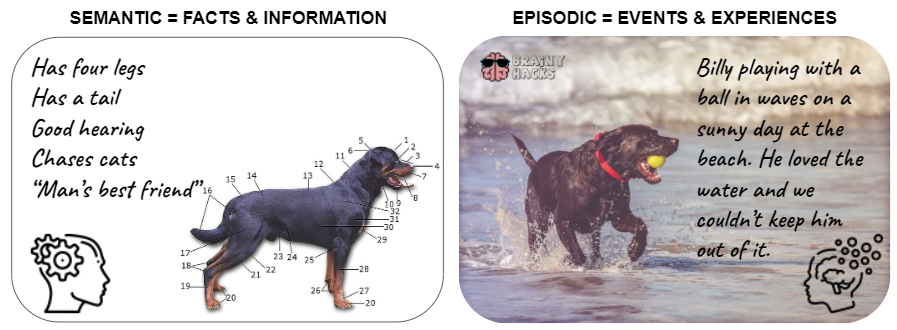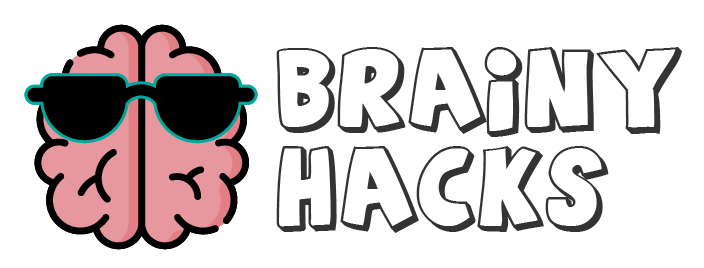Chances are, you’ve landed on this page because you’re interested to learn more about human memory, but all the different aspects of it are quite confusing! What is episodic memory? How is it different from semantic memory? Is it explicit or implicit? We’re going to explain it all in detail so that by the end of this article, you’ll have a solid and clear understanding of episodic vs semantic memory. Let’s get started!
The first order of business is defining long-term memory and the groups this function falls into. Long-term memory, abbreviated to LTM, is memories or information that is held by the brain indefinitely. It’s different from working memory and short-term memory which hold information temporarily and don’t manipulate the memory either.
The term “long-term memory” comes from a model proposed by Richard Atkinson and Richard Shiffrin back in the 1960s, called the Atkinson-Shiffrin model. It goes by other names too, like the multi-store or modal model.
Table of Contents
Important definitions explained
Within long-term memory, classifications split into two groups: The first is declarative memory (also called explicit memory), and non-declarative memory (also called implicit memory). We’re going to be focussing on declarative/explicit memory in this article, but let’s quickly take a look at non-declarative/implicit memory for interest’s sake.
Simply put, implicit memory is a form of long-term memory that operates on a subconscious level. A common example of implicit memory is procedural memory. It’s the skills you learn how to do that then go into a kind of autopilot. You don’t really think about how you get dressed in the morning, eat your food with a knife and fork, or tie a tie or a shoelace whenever you perform these tasks. You also don’t consciously think about how to operate a smartphone or tablet, how to open up and use apps or an Internet browser, and so on. When it comes to implicit memory, the formation of these memories can take place quite rapidly. In fact, sometimes you only need to be shown or do something once in order to “get it”. Implicit memory isn’t just linked to processes though; it has the ability to affect one’s behavior and thoughts.
Now back to explicit memory. This is the opposite of implicit memory because it is the conscious recollection of information, prior experiences, ideas, and concepts. It relies on acquiring information, putting it all together in a process of consolidation, and then being able to retrieve that information when it’s needed. Unlike implicit memory, oftentimes, explicit memory takes more time. It takes gradual learning with multiple experiences of the stimulus to really “sink in”.
Explicit memory is then divided into two sub-categories called episodic memory, which is the storage and recollection of specific personal experiences, and semantic memory, which is storing and recollecting factual information.
Here’s a flow diagram that you’ll find useful when figuring out the differences between episodic and semantic memory:
Episodic vs semantic memory explained
Now let’s get into more detail about these kinds of memory. Episodic memory, like the name suggests, centers on specific “episodes” or events in someone’s life. And because each person is different and has different perspectives and experiences from one another, episodic memories even of the same event are going to be unique to each person. This makes episodic memory so important in a person’s self-identity as it’s the memories they form of themselves and their lives over time. It’s also closely linked to autobiographical memory – but we won’t’ stray into this here.
Episodic memories are stored in the limbic system, a structure of the brain also called the paleomammalian cortex. It’s situated beneath the medial temporal lobe in the cerebrum, which sits towards the front of the entire brain structure. The front of the brain, simply put, is where all the “higher functions” of being a human live – where the structures controlling our emotions, behavior, long-term memory, reasoning, logic, and creativity can be found. Interestingly, it’s also where our olfactory sensory processing takes place, which is why smelling something familiar can trigger powerful and vivid memories. Here’s a quick video explainer of episodic memory if you prefer an audio-visual explanation:
So what of semantic memory? This refers to general or world knowledge that we accumulate throughout our lives. Think of it as your pub quiz database. It’s all the accumulated facts, ideas, concepts, and meanings of things that are interconnected with experience and culture. You can continually add to and modify this kind of memory too – you can use your semantic memory acquired in the past to learn new things, or when you learn some new facts, or ideas and concepts that upend your previous knowledge, so to your sematic memory can be modified.
Here’s another quick explainer of semantic memory if videos help you understand better:
To give you an example for distinguishing episodic memory and semantic memory, let’s think about a dog. Semantic memory is about all the information and facts you know about dogs. They have four legs, a wagging tail, maybe you even recall information about specific breeds, long hair or short, big or small, long nose or a squashed face. Even what we think culturally about dogs is part of semantic memory: man’s best friend. On the other hand, episodic memory is about your personal experience and perception of dogs in your life. Perhaps you recall the time one chased you as a child and made you scared of dogs, or the way your puppy would lick your face when you got home and made you feel happy.
Below are some examples of episodic memory vs semantic memory to make things really clear.

Episodic memory examples
Think experiences, emotions, meaningful events, and memories from the past:
- A pet you had in your childhood
- Your first job interview
- A particular test you failed
- An award you were presented with
- When you had an accident and injured yourself
- Something traumatic like a death in the family
- A book you read that had an impact on you
Semantic memory examples
Think facts, information, and skills:
- London is the capital of England and the United Kingdom
- A daffodil is yellow
- Humans breathe in oxygen and breathe out carbon dioxide
- Recognizing and naming colors
- Being able to describe what a dog is
- Being able to use a smartphone
Interdependence of episodic and semantic memory
Here’s a really cool thing about episodic and semantic memory… there’s a thing called integration. This is when you can’t quite remember something and so you draw on other information to bring about recall.
For example, you’re trying to remember the restaurant where you had an amazing burger. You don’t remember the name or where it was… but when you start thinking about it, you remember that it was a fall afternoon and the wind had blown leaves from the park into the entrance (experience = episodic). The park… now this was a 20-minute walk from your apartment down 5th Street (fact = semantic). You remember going with your friend and having a good time (experience = episodic), and that you laughed because the restaurant had the same name as your friend (fact = semantic). Your friend’s name was Jamie (fact = semantic). Ah-ha! The restaurant was called “Jamie’s” (fact = semantic).
This is why being present in your life is so important for memory formation – not just missing out on episodic memories because, rather than observing that the spring flowers are out along your bus route, you’ve fallen down a forgettable YouTube rabbit hole. Being present and exposing yourself to opportunities for both episodic and semantic memories can integrate to help you remember more things.
For example, if you know your neighborhood really well, you can use it as a map when applying the method of loci for memory recall. Similarly, you might not be remembering your facts when applying rote memorization because there’s no emotional connection to the content you’re trying to remember.
Why can people with dementia remember some things and not others?
There’s not a straightforward or simple answer to this, but when it comes to episodic vs semantic memories, it’s likely because they’re unable to create new memories. The progressive neocortical degeneration will affect some areas earlier and/or more severely than others. In other words, someone suffering from Alzheimer’s disease will not be able to encode facts or experiences firstly into short-term or working memory and then into long-term memory (whether that’s episodic or semantic). This is why they might not remember what they ate for breakfast or where they are right now, but they can remember the distant past very clearly because it’s already been deeply encoded. It could also be because of a lack of integration that we spoke about earlier. Memories from long ago will have more episodic and semantic memories to draw on to trigger a memory, such as smell, or seeing an old photo. On the other hand, there may not be enough interconnectedness of semantic memories and they will get lost over time.
Nevertheless, Alzheimer’s disease and dementia are tragic and heartbreaking diseases where even the strongest facts, like who someone is, or precious memories, like a cherished family holiday, eventually become lost. All we can hope is that research reveals the causes and we can develop prevention strategies or a cure.
Conclusion
Through this article, we’ve hopefully made it more clear about the difference between episodic memory vs semantic memory. You’ll now know that episodic memories are related to events and specific memories of the past, while semantic memory relates to facts, information, and skills. These are independent of each other, but not necessarily isolated from each other. In fact, we’ve provided examples of how episodic and semantic memories integrate with each other to trigger recall.
If you’ve enjoyed what you’ve read, why not browse more of our articles that explore memory and ways to improve studying through different techniques.
References and Image Sources
Featured Image
Memory flow chart
Definitions
The pivotal role of semantic memory in remembering the past and imagining the future
McRae, Ken; Jones, Michael (2013). “Semantic Memory”. In Reisberg, Daniel (ed.). The Oxford Handbook of Cognitive Psychology. New York, NY: Oxford University Press. pp. 206–216. ISBN 9780195376746.
Ullman, MT (2004). “Contributions of memory circuits to language: the declarative/procedural model”.
Lazzarim, Mayla K, Targa, Adriano, Sardi, Natalia F, et al. Pain impairs consolidation, but not acquisition or retrieval of a declarative memory. Behavioural Pharmacology. 2020;31(8):707-715. doi:10.1097/FBP.0000000000000576.
Kandel ER, Dudai, Y, Mayford MR. (2014). The molecular and systems biology of memory. Cell157:163–186
Schacter, D. L. (1987). “Implicit memory: history and current status”


157 thoughts on “Episodic vs Semantic Memory”
Comments are closed.